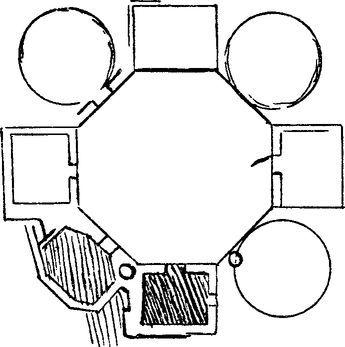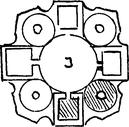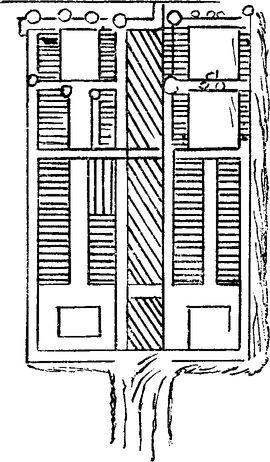Notebooks (60 page)
Authors: Leonardo da Vinci,Irma Anne Richter,Thereza Wells
Tags: #History, #Fiction, #General, #European, #Art, #Renaissance, #Leonardo;, #Leonardo, #da Vinci;, #1452-1519, #Individual artists, #Art Monographs, #Drawing By Individual Artists, #Notebooks; sketchbooks; etc, #Individual Artist, #History - Renaissance, #Renaissance art, #Individual Painters - Renaissance, #Drawing & drawings, #Drawing, #Techniques - Drawing, #Individual Artists - General, #Individual artists; art monographs, #Art & Art Instruction, #Techniques

In a letter dated 1515 Andrea Corsali writes to Giuliano de’ Medici of some gentle people called Guzzarati who refused to partake of food that had blood, who had agreed among themselves to do no harm to any living thing, ‘just like our Leonardo da Vinci’.
With the death of Giuliano de’ Medici on 17 March 1516 Leonardo lost his patron, and his hopes of finding a fruitful field for his activities in Rome were shattered. The following note reflects his disappointment. He was thinking of the brilliant outset of his career when Lorenzo il Magnifico had sent him to Ludovico Sforza, and of the indifference and incomprehension of the Pope, his son.
The Medici made me and destroyed me.
177
177
His last dated note written in Rome shows him interested in the measures of one of its basilicas.
San Paolo in Rome has 5 naves and 80 columns and in its width across the naves is 130 braccia, and from the steps of the high altar to the door is br. 155, and from these steps to the further wall at the back of the high altar br. 70, and the portico is 130 br. long and 17 br. wide. Taken August 1516.
178
VI. FRENCH PERIOD (1516-1519)178
During 1516 the 64-year-old Leonardo accepted the invitation of Francis I to become
peintre du Roy
and went to stay at the small chateau of Cloux, near the royal residence at Amboise on the Loire. The French king had a sincere love of letters and art, and during his reign and that of his predecessor numerous Italian artists and craftsmen were installed at the court. He greatly admired Leonardo and told Benevenuto Cellini twenty years later ‘that he believed no other man had been born who knew as much about sculpture, painting and architecture, but still more that he was a very great philosopher’. It is said that he enjoyed Leonardo’s conversation almost every day.
peintre du Roy
and went to stay at the small chateau of Cloux, near the royal residence at Amboise on the Loire. The French king had a sincere love of letters and art, and during his reign and that of his predecessor numerous Italian artists and craftsmen were installed at the court. He greatly admired Leonardo and told Benevenuto Cellini twenty years later ‘that he believed no other man had been born who knew as much about sculpture, painting and architecture, but still more that he was a very great philosopher’. It is said that he enjoyed Leonardo’s conversation almost every day.
The following note reveals Leonardo’s attitude towards his listeners in conversation.
Words which do not satisfy the ear of the listener weary him or vex him, and you will often see symptoms of this in the frequent yawns of such listeners; therefore when you speak before men whose good will you desire, and see such an excess of fatigue, abridge your speech, or change the subject; and if you do otherwise you will earn dislike and hostility instead of the hoped for favour. And if you want to see in what a man takes pleasure, without hearing him speak, change the subject of your discourse in speaking to him and, when he presently becomes intent and does not yawn nor wrinkle his brow and the like, you may be certain that the matter which you are speaking is agreeable to him.
179
179
Ascension Day at Amboise in Cloux. May 1517.
180
180
On 1 October 1517 Rinaldo Ariosto wrote to the Marquess Gianfrancesco Gonzaga describing a festival at Argentan which had been organized by Leonardo for Francis I and where a mechanized lion was much admired.
On 10 October 1517 the Cardinal Luigi of Aragon visited Leonardo’s studio. He was accompanied by his secretary Antonio de Beatis, who wrote the following account of the event: ‘In one of the outlying parts
[
of Amboise
]
Monsignor and the rest of us went to see Messer Leonardo da Vinci, the Florentine, who is more than seventy years old, and is one of the most excellent painters of the day. He showed His Eminence three pictures, one of a certain Florentine lady done from life for the late Magnificent Giuliano de’ Medici, another a young John the Baptist, and a third the Madonna and Child seated on the lap of St Anne, all perfect. Nothing more that is fine can be expected of him, however, owing to the paralysis, which has attacked his right hand. A Milanese, who was educated by him and paints excellently, lives with him. Although Leonardo can no longer paint with his former sweetness he can still draw and teach others. This gentleman has written of anatomy with such detail, showing with illustrations the limbs, veins, tendons, intestines and whatever else there is to discuss in the bodies of men and women in a way that has never yet been done. All this we have seen with our eyes; and he said that he had dissected more than thirty bodies of men and women of all ages. He has also written on the nature of water, on various machinery and on other matters, which he has set down in an infinite number of volumes all in the vulgar tongue; which if they were published would be useful and very delightful.’
[
of Amboise
]
Monsignor and the rest of us went to see Messer Leonardo da Vinci, the Florentine, who is more than seventy years old, and is one of the most excellent painters of the day. He showed His Eminence three pictures, one of a certain Florentine lady done from life for the late Magnificent Giuliano de’ Medici, another a young John the Baptist, and a third the Madonna and Child seated on the lap of St Anne, all perfect. Nothing more that is fine can be expected of him, however, owing to the paralysis, which has attacked his right hand. A Milanese, who was educated by him and paints excellently, lives with him. Although Leonardo can no longer paint with his former sweetness he can still draw and teach others. This gentleman has written of anatomy with such detail, showing with illustrations the limbs, veins, tendons, intestines and whatever else there is to discuss in the bodies of men and women in a way that has never yet been done. All this we have seen with our eyes; and he said that he had dissected more than thirty bodies of men and women of all ages. He has also written on the nature of water, on various machinery and on other matters, which he has set down in an infinite number of volumes all in the vulgar tongue; which if they were published would be useful and very delightful.’
On 11 October De Beatis adds in his diary, ‘there was also a picture in which a certain lady from Lombardy is painted in oil, from life, quite beautiful, but in my opinion not as much as the lady Gualanda, the lady Isabella Gualanda’.
In this note addressed to Leonardo he is referred to as ‘paintre du Roy’. The writing is partly illegible.
To Monsieur de Vinci . . . the horses of the king’s equerry. . . .
Continue the payment to Mons. Lyonard, painter to the king. Amboise.
181
181
Plan to construct transportable houses near the royal hunting lodge at Romorantin.
On moving houses.


Let the houses be moved and arranged in order; and this will be done with facility because such houses are at first made in pieces on the open places, and can then be fitted together with their timbers in the site where they are to be permanent.
Let the men of the country partly inhabit the new houses when the court is absent.
The main underground channel does not receive turbid waters, but that water runs in the ditches outside the town with four mills at the entrance and four at the outlet; and this may be done by damming the water above Romorantin.

There should be fountains made in each piazza.
182
182
French canal project
If the river
mn
, a tributary of the river Loire, were turned with its turbid waters into the river of Romorantin it would enrich the lands that it irrigated and would render the country fertile to supply food for the inhabitants and it would serve as a navigable canal for merchandise. . . .
182
mn
, a tributary of the river Loire, were turned with its turbid waters into the river of Romorantin it would enrich the lands that it irrigated and would render the country fertile to supply food for the inhabitants and it would serve as a navigable canal for merchandise. . . .
182

The eve of St Anthony [13 January 1518] I returned from Romorantin to Amboise and the king left Romorantin two days before.
183
183
In May 1518 the French court at Amboise celebrated the baptism of the dauphin and the marriage of Lorenzo de’ Medici, the Pope’s nephew, to Maddalena de la Tour d’Auvergne, the niece of Francis I. The festivities went on for weeks, and included a brilliant tournament. In the evening of 19 June 1518, the king brought his great company of guests to Leonardo’s chateau at Cloux where the court had been turned into a wonderful ballroom covered by a dome of deep blue fabric from which the sun, moon, and stars shone on the guests below. This magic night at Cloux brought the festivities at Amboise to a close.
On the 24th of June, 1518, the day of St John, at Amboise in the palace of Cloux.
184
184
This is the last dated note in Leonardo’s hand.
LEONARDO’S WILL
April 23, 1519.
Be it known to all persons, present and to come, that at the court of our Lord the King at Amboise before ourselves in person, Messer Leonardo da Vinci, painter to the King, at present staying at the place known as Cloux near Amboise, duly considering the certainty of death and the uncertainty of its time, has acknowledged and declared in the said court and before us that he has made according to the tenor of these presents, his testament and the declaration of his last will as follows:
And first he commends his soul to our Lord, Almighty God, and to the glorious Virgin Mary, and to our Lord Saint Michael, to all blessed angels and Saints male and female in Paradise.
Item. The said Testator desires to be buried within the church of St Florentin at Amboise, and that his body shall be borne thither by the chaplains of the church.
Item. That his body may be followed from the said place to the said church of St Florentin by the collegium of the said church, that is to say by the rector and the prior, or by their vicar and chaplains of the church of St Denis at Amboise, also the Minors of the place; and before his body shall be carried to the said church this Testator desires that in the said church of St Florentin three grand masses shall be celebrated by the deacon and sub-deacon and that on the day on which these three high masses are celebrated, thirty low masses shall also be performed at St Gregory.
Item. That in the said church of St Denis similar services shall be performed as above.
Item. That the same shall be done in the church of the said friars and Minors.
Item. The aforesaid Testator gives and bequeaths to Messer Francesco da Melzo, nobleman of Milan, in remuneration for services and favours done to him in the past, each and all of the books the testator is at present possessed of, and the instruments and portraits appertaining to his art and calling as a painter.
Item. The same Testator gives and bequeaths henceforth for ever to Batista de Vilanis one half, that is, the moiety of his garden, which is outside the walls of Milan, and the other half of the same garden to Salaì his servant; in which garden aforesaid Salaì has built and constructed a house which shall be and remain henceforth in all perpetuity the property of the said Salaì, his heirs and successors; and this is in remuneration for the good and kind services which the said de Vilanis and Salaì, his servants, have done him in past times until now.
Other books
The Trap by John Smelcer
You by Charles Benoit
A Hoe Lot of Trouble by Heather Webber
Tempest in a Teapot (A Teapot Collector Mystery) by Amanda Cooper
Forget You by Jennifer Snyder
The Hunter's Moon (The Secret Warrior Series) by Beth Trissel
Dutch Shoe Mystery by Ellery Queen
The Present by Johanna Lindsey
Wild by Lincoln Crisler
The Elementary Particles by Michel Houellebecq